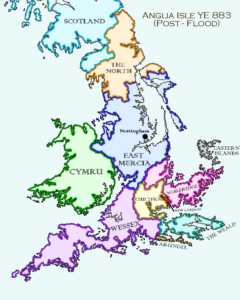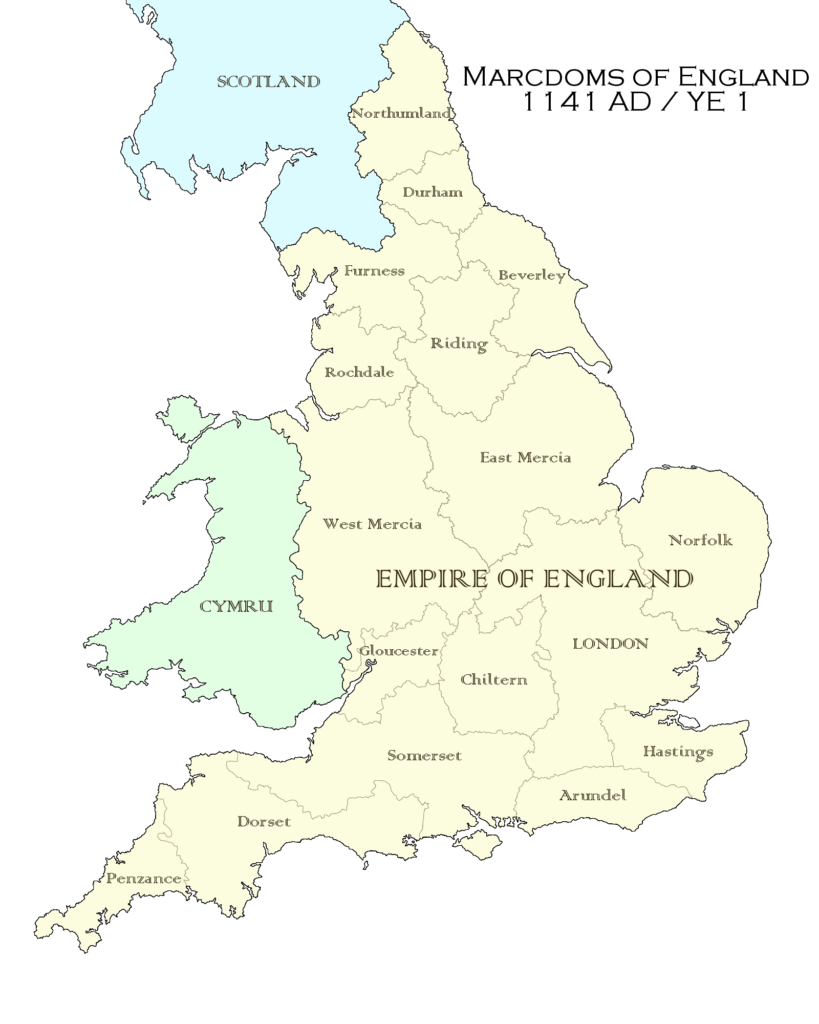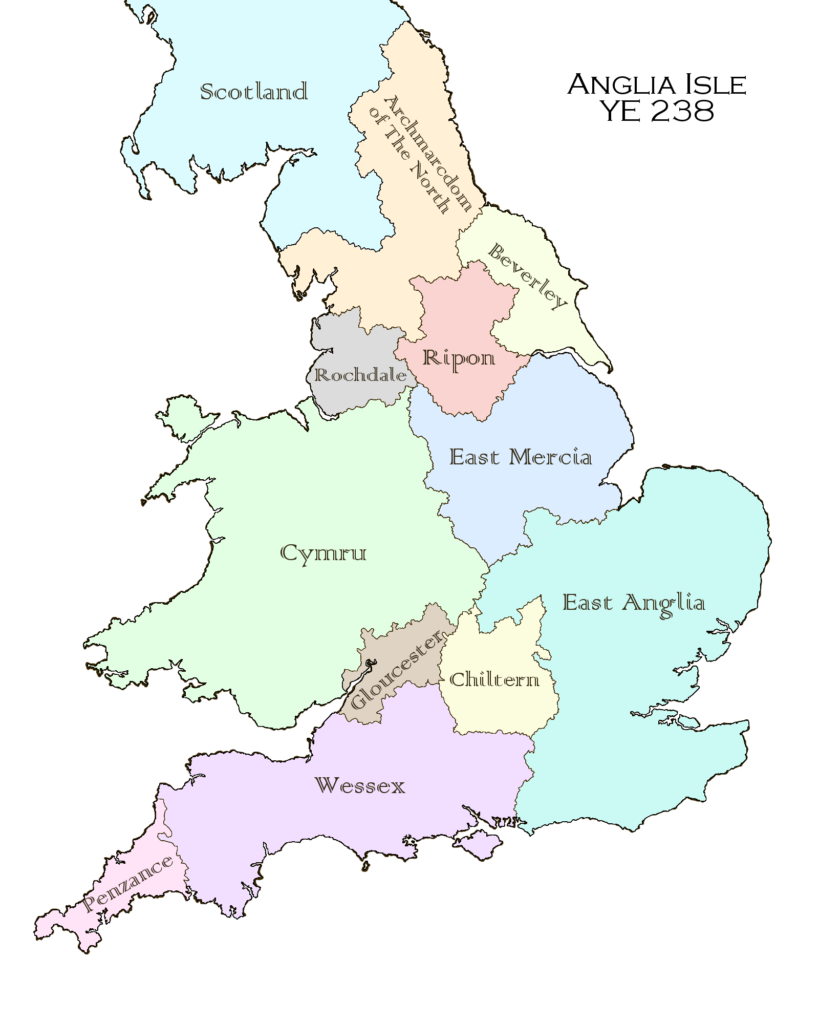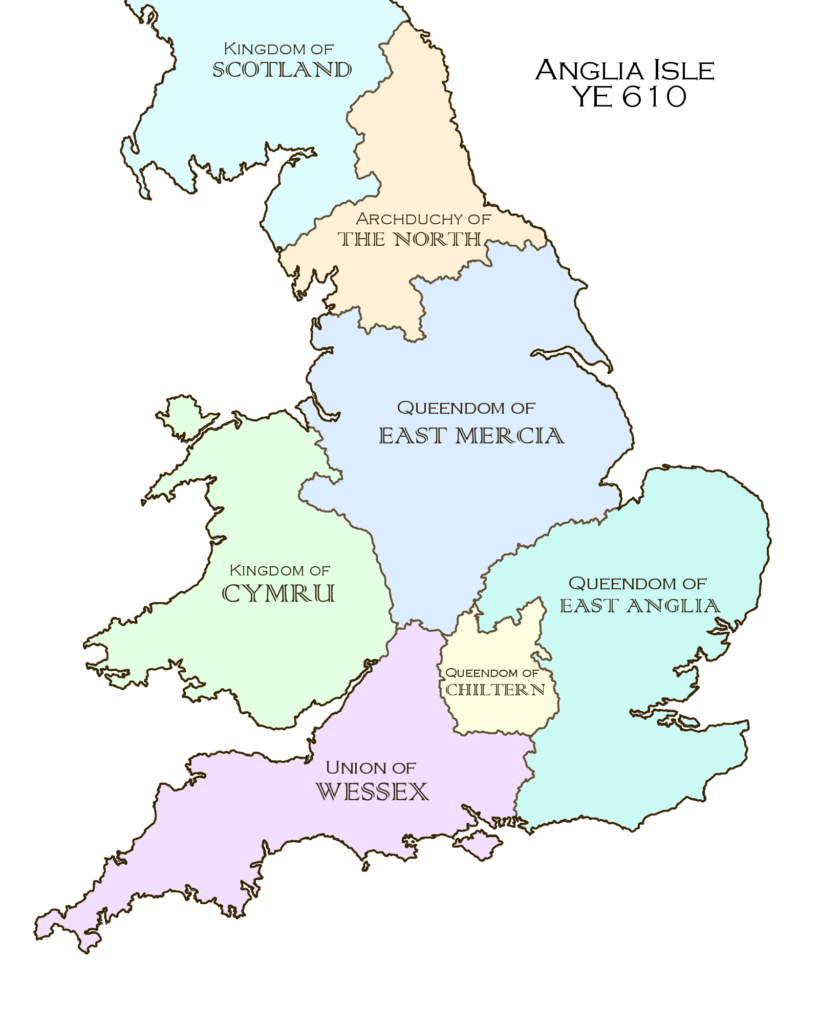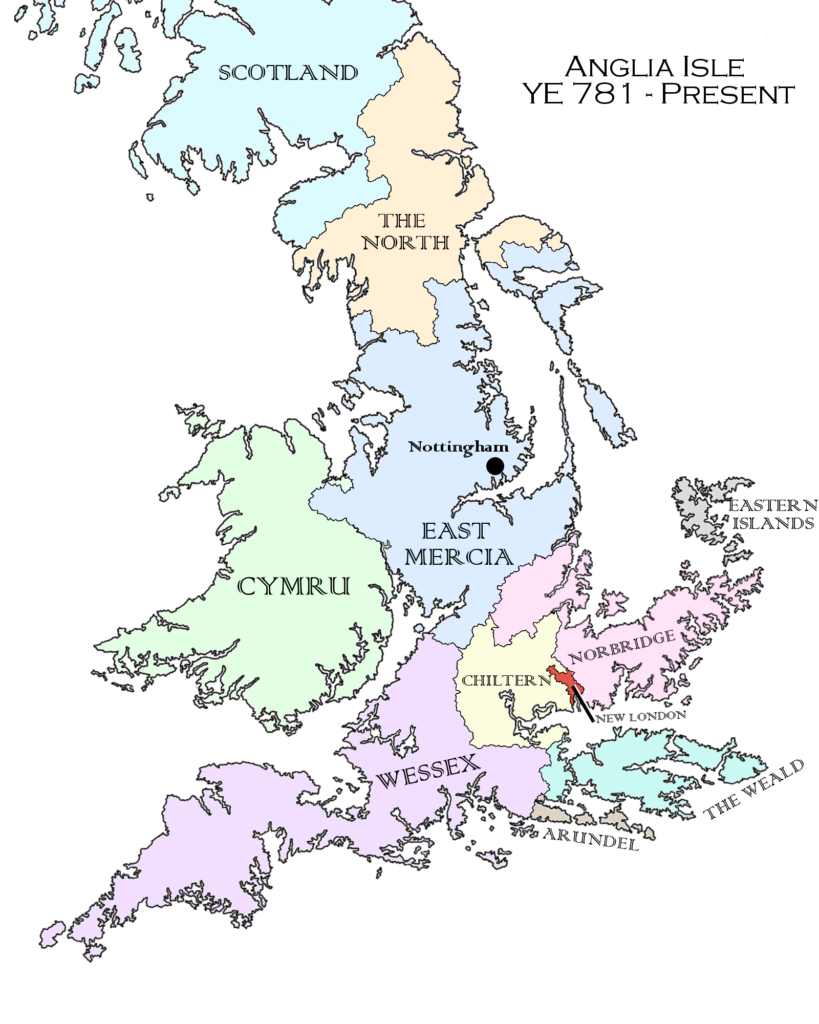Anglia Isle
Jump to
Recommended Pages
The Anglia Isle is a blanket designation for the Kingdom of Cymru, The Kingdom of Scotland and the landmass formerly known as England. The name has been in place since the beginning of the Second Age of Hycath, though the exact make-up of the polity and its systems of governance have evolved.
The Anglia Isle currently comprises eleven autonomous countries and has an approximate population of 41,780,000.
History
The Evolution of England
At the dawn of the First Hycath War, England – then ruled by the Normans – operated as a single monarchy with a manorial system and a series of counties based on the shires of its previous rulers, the Anglo-Saxons. London was its capital.
When Empress Matilda I won the First Hycath War in 1141AD / YE 1, she reorganised the existing counties into sixteen Marcdoms, supporting London as a capital city-state under her jurisdiction. The former patriarchy became a matriarchy, and each Marcdom was entrusted to a loyalist of Matilda including several Hycathae, many of them nominated as reward for exceptional service in the war. Names for Marcdoms were based variously upon previous shires, manors and cities.
Creation of the Anglia Isle
The First Age of Hycath culminated in YE 238 with the Sacking of the Vatican, a pan-European conflict between Hycathism and the Church which was heavily influenced by the English Hycathic establishment under Empress Matilda VI. Following her victory, Matilda became obsessed with the idea of subjugating Europe to her own rule. Mary-Anne Fitzwalter, 9th Margrave of East Mercia and commander of Matilda’s forces, felt compelled to kill her in order to avoid disaster.
Mary-Anne returned to England from fighting at the Vatican, determined to prevent a second succession crisis. Together with the other ruling Margraves she formally dissolved the country of England, ending centralised rule from London and renaming the landmass the Anglia Isle. The Marcdoms of the previous two centuries were reimagined as eleven autonomous Queendoms with their own capitals (together with Cymru and Scotland bringing the total number of countries on the Anglia Isle to thirteen). Some, such as West and East Mercia, were geographically identical. Others were formed from the merger of multiple Marcdoms. For example, the merger of the Mardcoms of Dorset and Somerset formed the Queendom of Wessex. Queendoms themselves were divided into sub-administrative Marcdoms. Mary-Anne herself became the first Queen of East Mercia.
The Kingdom of Cymru took advantage of political unrest, following the creation of the new Queendoms, and invaded neighbouring West Mercia. The previous English armed forces had been decimated and West Mercia had not yet established its own army. As a result, the fledgling Queendom was no match for the Cymraeg forces. A Queendom for only six weeks, West Mercia had no choice but to surrender, becoming part of Cymru.
Aside from the Archmarcdom of the North – merged from Durham, Furness and Northumberland – the term Queendom was exclusively used, reflecting the continuing matriarchy of the new Second Age of Hycath that would continue for approximately three centuries.
Acorn Uprising and Beyond
The Second Age of Hycath culminated in a battle with the Olivers, originally a Founding Family of East Mercia. The Olivers’ forebears had been exiled from the Queendom early 4th Century YE for attempting a coup, eventually settling in Rochdale. The Olivers were at odds with the continuing matriarchal and matrilineal system under which the Anglia Isle operated. By this time they had designs on refashioning England as a single monarchy under their rule. To these ends, they murdered the Hycathic Queen Alviva of East Mercia and her only daughter and heir. This set in motion the chain of events that would lead to the Acorn Uprising and the final battle in YE 533. At this battle, Jonathan Fitzwalter – heir to the throne of East Mercia and Queen Alviva’s brother – and his wife Eleanor Loxley defeated the Olivers with the help of Cymru, Ripon and the Archmarcdom of The North.
A further punishment dealt upon the family brought more geopolitical changes to the Anglia Isle. Rochdale was disintegrated and swallowed up by East Mercia. East Mercia would expand further in the decades that followed and conquered the Queendoms of Ripon and Beverly and eventually managed to bring half of the original West Mercia territories under their banner. In the southwest, the Queendom of Wessex absorbed that of Penzance, the only Queendom left untouched in the South by the merger three centuries previously. A couple of decades later Wessex also absorbed what was left of Gloucester after Cymru and East Mercia conquered some of its territories. The number of countries was thus reduced from thirteen to seven.
Jonathan’s crowning as King of East Mercia ended the strict matriarchy of Hycath Ages past and ushered in a new Age of Equality where rulers were not subject to gender norms and discrimination. Over time, the countries of the Anglia Isle would interrogate the classification of Queendom, some choosing to retain it and others adopting different terms in accordance with their evolving national identities. This accounts for the spread of terminology in today’s countries.
The Change
The Great Torrent of YE 781 was so physically devastating to the Anglia Isle that major restructuring of its countries was needed to make up the shortfall. The heaviest land losses were observed along the eastern coastline of the Isle, with East Mercia and East Anglia severely reduced. The west was not spared, with Wessex somewhat depleted and Cymru losing small parcels of land land.
The Torrent had its most definitive effect on cities and towns, with many lost – Gloucester and London most notably. As such, it became unsustainable for countries to have multiple large settlements, and capital cities inevitably became the main residence of the surviving populations. As a result, countries were restructured around these cities, especially in the hardest-hit southeast, where a city-state of New London was founded to the west of the original site, and the State of Norbridge crystallised around the new city of Norbridge, a portmanteau replacement for the now-submerged Norwich and Cambridge.
The Torrent also left many former eastern territories as islands. The Archmarcdom of The North and East Mercia have kept their claim to those islands in their sphere of jurisdiction, whereas a series of island remnants of the former East Anglia seceded to form the Eastern Isles.
With the splitting of East Mercia into five sovereign countries, the total number of autonomous countries on the Anglia Isle was restored to it’s original number of eleven.
Anglia Isle Today
The countries of the Anglia Isle in the present day, together with their populations, are listed below.
| COUNTRY | CAPITAL | PREVAILING SYSTEM | POPULATION |
| Kingdom of Scotland | Edinburgh | Constitutional Monarchy | 3,800,000 |
| Kingdom of Cymru | Cardiff | Absolute Monarchy | 5,900,000 |
| Union of Wessex | Exeter | Democracy with ceremonial Marcdoms | 4,700,000 |
| City of Arundel | City of Arundel | Run by guilds | 223,000 |
| Republic of Weald | Maidstone | Presidential Republic | 1,400,000 |
| New London | New London | Business run state | 543,000 |
| State of Norbridge | Norbridge | Democratic republic | 827,000 |
| Queendom of Chiltern | Oxford | Electoral Queendom | 2,300,000 |
| Queendom of East Mercia | Nottingham | Absolute Monarchy | 13,100,000 |
| Archmarcdom of the North | Carlisle | Archmarcdom | 8,200,000 |
| Eastern Isles | None | Socialist Utopia | 87,000 |

